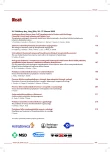-
Medical journals
- Career
Cardiac surgery as a significant interference with a patient coagulation status
Authors: R. Brát
Authors‘ workplace: Kardiochirurgické centrum FN Ostrava, přednosta prim. MUDr. Radim Brát, Ph. D.
Published in: Vnitř Lék 2009; 55(3): 233-235
Category: 15th Parizek's Days
Overview
Cardiac surgery has been advancing intensively in recent years. However, it is often forgotten that cardiac surgery interventions represent a significant interference with patient’s coagulation status. This paper summarizes the main processes in the course cardiac surgery that lead to coagulation disorder. These include: • haemodilution resulting from extracorporeal circuits crystalloid priming and the use of cardioplegic solutions leading to the reduction in coagulation factors concentration and the thrombocytes count • full heparinisation during extracorporeal circulation that represents a significant interference with coagulation that may persist for some time even after all heparin has been bound • contact of the blood with inorganic surface that results in an activation of the coagulation cascade and subsequent consumption of coagulation factors and thrombocytes • surgery‑related trauma with activation of the external coagulation pathway leading to activation of the coagulation cascade and subsequent consumption of coagulation factors and thrombocytes • blood re‑transfusion from the pericardial cavity and subsequent activation of the external coagulation pathway leading to consumption of coagulation factors and thrombocytes • hypothermia leading to thrombocyte dysfunction and initiation of fibrinolysis • blood loss furthering the haemodilution and reduction in coagulation factors concentration and thrombocytes count. The overview provided suggests that cardiac surgery conducted with the support of extracorporeal circuit represents a significant interference with the coagulation status of the patient. Awareness of the above listed changes is necessary to secure correct post‑operative management of coagulation disorders.
Key words:
extracorporeal circuit – cardiac surgery – coagulation disorder
Sources
1. Hunt BJ, Parratt RN, Segal HC et al. Activation of Coagulation and Fibrinolysis During Cardiothoracic Operations. Ann Thorac Surg 1998; 65 : 712–718.
2. Chandler WL, Velan T. Estimating the rate of thrombin and fibrin generation in vivo during cardiopulmonary bypass. Blood 2003; 101 : 4355–4362.
3. Mariani MA, Gu YJ, Boonstra PW et al. Procoagulant activity after off-pump coronary operation: is the current anticoagulation adequate? Ann Thorac Surg 1999; 67 : 1370–1375.
4. Brát R, Tošovský J, Januška J et al. Comparison between blood and crystalloid cardioplegia in patients with left ventricular dysfunction undergoing coronary surgery. Acta Medica (Hradec Králové) 2000; 43 : 107–110.
5. Dixon B, Santamaria J, Campbell D. Coagulation Activation and Organ Dysfunction Following Cardiac Surgery. Chest 2005; 128 : 229–236.
6. Despotis GJ, Joist JH, Goodnough LT. Monitoring of hemostasis in cardiac surgical patients: impact of point-of-care testing on blood loss and transfusion outcomes. Clin Chem 1997; 43 : 1684–1696.
Labels
Diabetology Endocrinology Internal medicine
Article was published inInternal Medicine

2009 Issue 3-
All articles in this issue
- Venous thromboembolism prophylaxis in orthopaedics and traumatology
- Antithrombotic prophylaxis during pregnancy
- The profylaxis of venous thromboembolism in gynecology
- Cardiac surgery as a significant interference with a patient coagulation status
- Pre‑operative care for cardiac surgery patients with cold antibody disorder, cryoglobulinaemia and cryofibrinogenemia
- Thrombophilic states: their relevance in prevention and treatment of venous thromboembolism
- Antiphospholipid syndrome in the year 2009
- Blood platelets metabolic and activation processes and options for their inhibition
- Inferior vena cava filters in pulmonary embolism prevention
- Preparation of patients on anticoagulant treatment for invasive surgery
- Bleeding complications of anticoagulant therapy
- Laboratory procedures following thrombocytopenia diagnosis
- Advances in antithrombotic treatment – antithrombotics with anti‑Xa effect
- Molecular methods in thrombophilic states diagnostics
- The Salvage of Ischaemic Limb by Therapeutical Angiogenesis
- The use of adult human bone marrow stem cells in the treatment of spinal injury
- Our first experiences with autologous transplantation of bone marrow stem cells to treat pseudarthrosis, delayed fracture healing and long bone defects fracture
- Venous thromboembolism prophylaxis in internal medicine
- Prevention of venous thromboembolism in surgery, laparoscopic surgery and urology
- Prophylaxis and treatment of thromboembolism in oncology
- Autologous Bone Marrow Stem Cell Transplantation in Patients with End‑Stage Chronical Critical Limb Ischemia and Diabetic Foot
- Thrombotic Complications in Children with Cancer
- Treatment of deep vein thrombosis with continuous intravenous infusion of LMWH in children – an alternative to subcutaneous application when needed
- Internal Medicine
- Journal archive
- Current issue
- Online only
- About the journal
Most read in this issue- Laboratory procedures following thrombocytopenia diagnosis
- Pre‑operative care for cardiac surgery patients with cold antibody disorder, cryoglobulinaemia and cryofibrinogenemia
- Venous thromboembolism prophylaxis in orthopaedics and traumatology
- Antithrombotic prophylaxis during pregnancy
Login#ADS_BOTTOM_SCRIPTS#Forgotten passwordEnter the email address that you registered with. We will send you instructions on how to set a new password.
- Career

